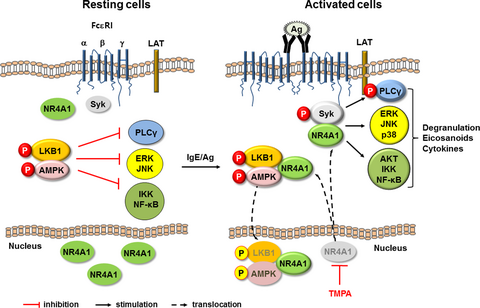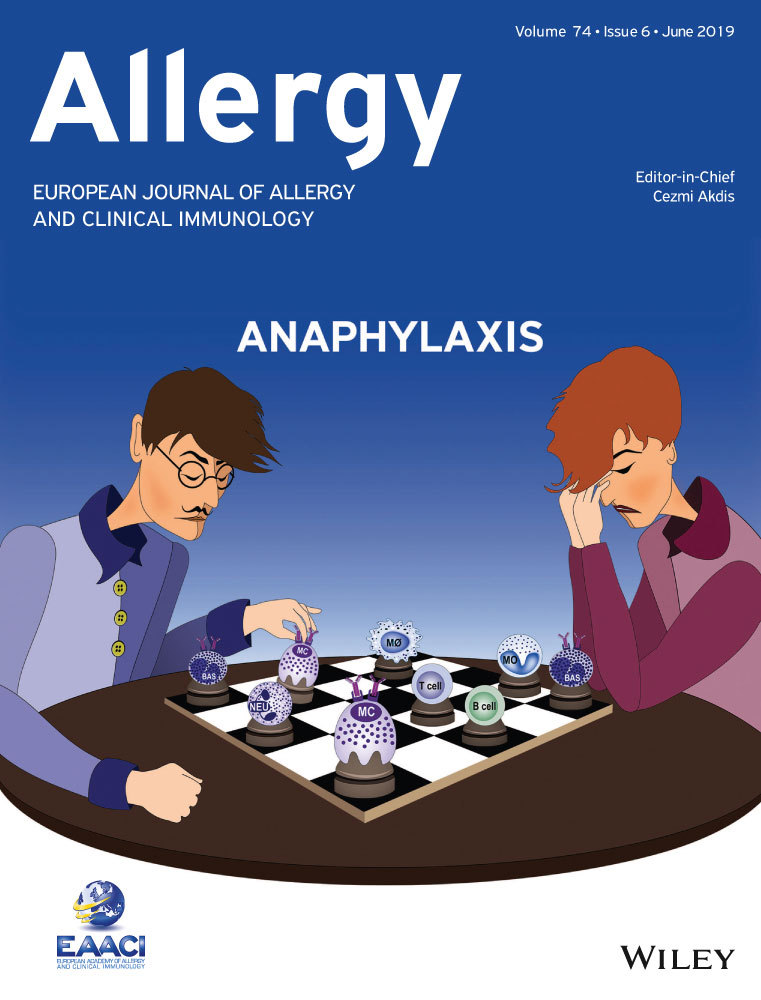The orphan nuclear receptor NR4A1 promotes FcεRI-stimulated mast cell activation and anaphylaxis by counteracting the inhibitory LKB1/AMPK axis
Abstract
Background
Nuclear receptor subfamily 4 group A member 1 (NR4A1), an orphan nuclear receptor, has been implicated in several biological events such as metabolism, apoptosis, and inflammation. Recent studies indicate a potential role for NR4A1 in mast cells, yet its role in allergic responses remains largely unknown.
Objectives
The aim of this study was to clarify the role of NR4A1 in mast cell activation and anaphylaxis.
Methods
To evaluate the function of NR4A1 in mast cells, the impacts of siRNA knockdown, gene knockout, adenoviral overexpression, and pharmacological inhibition of NR4A1 on FcεRI signaling and effector functions in mouse bone marrow–derived mast cells (BMMCs) in vitro and on anaphylactic responses in vivo were evaluated.
Results
Knockdown or knockout of NR4A1 markedly suppressed degranulation and lipid mediator production by FcεRI-crosslinked BMMCs, while its overexpression augmented these responses. Treatment with a NR4A1 antagonist also blocked mast cell activation to a similar extent as NR4A1 knockdown or knockout. Moreover, mast cell–specific NR4A1-deficient mice displayed dampened anaphylactic responses in vivo. Mechanistically, NR4A1 promoted FcεRI signaling by counteracting the liver kinase B1 (LKB1)/adenosine monophosphate-activated protein kinase (AMPK) axis. Following FcεRI crosslinking, NR4A1 bound to the LKB1/AMPK complex and sequestered it in the nucleus, thereby promoting FcεRI downstream signaling pathways. Silencing or knockout of LKB1/AMPK largely abrogated the effect of NR4A1 on mast cell activation. Additionally, NR4A1 facilitated spleen tyrosine kinase activation independently of LKB1/AMPK.
Conclusions
Nuclear receptor subfamily 4 group A member 1 positively regulates mast cell activation by antagonizing the LKB1-AMPK-dependent negative regulatory axis. This finding may provide a novel therapeutic strategy for the development of anti-allergic compounds.
Graphical Abstract
Nuclear receptor subfamily 4 group A member 1 augments mast cell activation by negatively regulating liver kinase B1/adenosine monophosphate-activated protein kinase and positively regulating spleen tyrosine kinase. Ethyl 2-[2,3,4-trimethoxy-6-(1-octanoyl)phenyl]acetate, a high-affinity nuclear receptor subfamily 4 group A member 1 antagonist, inhibits mast cell activation. Nuclear receptor subfamily 4 group A member 1 is a novel drug target for mast cell-dependent allergic diseases.
AMPK: AMP-activated protein kinase; LKB1: liver kinase B1; NR4A1: Nuclear receptor subfamily 4 group A member 1; Syk: spleen tyrosine kinase; TMPA: Ethyl 2-[2,3,4-trimethoxy-6-(1-octanoyl)phenyl]acetate
CONFLICTS OF INTEREST
The authors declare that they have no conflicts of interest.





